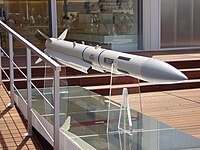
Photo from wikipedia
Abstract This paper investigates the feasibility of using an active dynamic vibration absorber (ADVA) for active vibration control of a flexible missile system through simulation. Based on the principles of… Click to show full abstract
Abstract This paper investigates the feasibility of using an active dynamic vibration absorber (ADVA) for active vibration control of a flexible missile system through simulation. Based on the principles of a dynamic vibration absorber (DVA), a ring-type ADVA is first designed to attenuate the elastic vibration of the flexible missile, and the design of the active controller adopts the proportional-integral-derivative (PID) control algorithm. The motion equations of a flexible missile with an ADVA, which is subjected to follower thrust at its aft end, are derived using the Lagrangian approach. Taking the minimum of the root mean square (RMS) of the lateral displacement response of the center of mass as the objective function, a genetic algorithm (GA) is used to optimize the parameter of the DVA and PID controller. The numerical calculations show that the ADVA and DVA are effective in suppressing the vibration and provide approximately 41.2% and 17.6% improvement, respectively, compared with the case of no DVA. The ADVA has better performance than the DVA. When the missile is subjected to follower thrust, the effect of vibration reduction is more effective than the case without follower thrust. It is feasible to reduce vibration and improve the stability of flexible missiles by means of the ADVA.
Journal Title: Defence Technology
Year Published: 2020
Link to full text (if available)
Share on Social Media: Sign Up to like & get
recommendations!